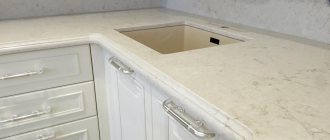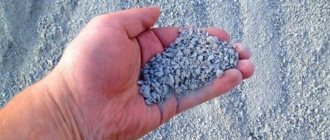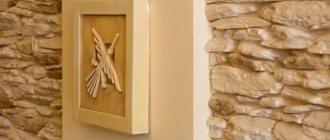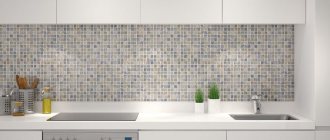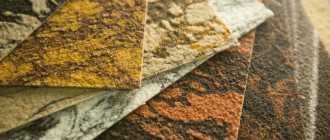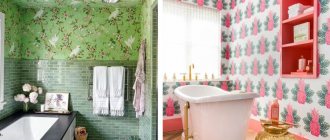Kinds
Decorative stone for interior decoration is divided into three types:
- cement;
- plaster;
- agglomerate.
There is another type of stone finishing - clinker tiles, reminiscent of brickwork. It is made using the same method as brick, only its thickness ranges from one to three centimeters.
The shapes for decorative stone can be different, regardless of its type.
Advantages of stones as a decorative material
Stone as a material used in landscape design has many advantages. Moreover, to start using it, you only need your desire. The costs are minimal, especially if you live in a rocky area: the stones may well end up in your garden, and you will only need to refine them a little to create the desired appearance of the garden. In addition, you can look for stones in nature and simply bring them to your site, and all this is free. The only thing is that if you want to transport a large boulder to your site, you will need the appropriate equipment. In other cases, the costs of purchasing material and transporting it are zero.
On a note! If you live in a region that is not rich in stones, then you will need to purchase them from the appropriate stores. And this will already cost money.
Another plus: you can create beautiful compositions from stones with your own hands, without the involvement of specialists. Of course, if you do not have a sense of taste and style, then it is better to consult with landscape designers or at least look at photo examples on the Internet.
Rock garden and garden path made of stones
It’s easy to create interesting compositions from stone. This material is already ready for use. And everything else can be done with your own hands.
The service life of stone structures is at least 50-60 years. So the decor, whatever it is, will decorate your area for many decades until you want to change it.
In addition, it is an environmentally friendly material, natural and completely safe both for your health and for plant crops. The stones are non-toxic, beautiful and do not require varnish. You can, of course, paint it if you wish, but even in this case the stone will still not become a source of toxic substances (if you choose the right paint).
Landscaping using stones
By the way, if the area is full of large stones, you shouldn’t always think about removing them. Sometimes you can leave everything in its natural form, but slightly modify it. Moreover, natural landscapes are now in fashion. Just plan the planting of plants on the site so that they fit well into the natural landscape. In this case, you will easily feel like you are in the wild, even if the house is located near the city.
Gypsum based
The gypsum version is the cheapest and lightest of all analogues. Therefore, it is used when decorating plasterboard surfaces that cannot withstand heavy loads.
Its disadvantages are that such products are very fragile, hygroscopic, and are destroyed by high humidity.
Finishing with gypsum-based decorative stone requires additional protective treatment. Usually this is a special impregnation or acrylic varnish.
Lay out a path of stones at your dacha
Stones will be an excellent basis for a garden path. You can use different materials for it, but it is best to choose cobblestones or rounded rubble stones. Sandstone with an anti-slip effect is also suitable, but it is quite expensive. Of course, you should not make stone paths throughout the entire area; they are not always convenient for transporting goods. Therefore, a small path near the house will be quite enough. Add low-growing plants, such as sedum or ephedra, to the edges of the finished path.
Cement based
One of the more popular finishing stones is made from a cement composition. It is durable, has a long service life, and can be easily washed with a brush of any hardness and using detergents.
The disadvantages are as follows:
- Difficulty cutting. When working, there is a need for a power tool.
- Heaviness. The weight is greater than that of gypsum, but much less than that of a natural product.
- Great cost. In the manufacturing process, expensive cement of the highest quality is used.
Types of stones for landscape design
There are two main types of stones used for landscape design - natural and artificial. Let's talk about them in more detail.
Natural stone is a natural material created by nature itself. As a rule, it has different sizes and shapes - you will never find absolutely two identical ones. This can be stone chips, small or large pebbles, large rock boulders, and so on. The following species are mainly used for landscaping.
Natural stone in landscape design
- Marble is a very durable type of stone that has original variegated colors. Ideal for finishing, often used in the form of crumbs, an excellent decorative option for flower beds and paths, allows you to create interesting multi-colored panels. It is not afraid of moisture, durable, but can make the soil around it alkaline.
Marble - Granite is a very hard rock of a gray-red hue, but sometimes yellow and pink varieties are found. Perfect for creating benches, paths, borders, artificial ponds. A very durable and strong option, but heavy and difficult to process, and also not a cheap species.
- Sandstone is a beautiful yellow-gray stone, ideal for finishing the base, creating partitions and walls. Fits perfectly into the environment. It is durable, inexpensive and not afraid of moisture. But you can’t find it in the form of blocks—mostly, only slabs. Well, in general, it cannot be called such a durable material. Sandstone
- Basalt is a porous stone, but very durable. It is not afraid of serious temperature changes and is suitable even for difficult climate conditions. Ideal for creating terraces, paths, and making sculptures from it. The material is wear-resistant, durable, but inexpensive. The disadvantages include the difficulty of processing and heavy weight.
- Limestone is light, light in color, perfect for creating garden furniture and alpine slides, and looks good in flower beds. Lightweight, inexpensive, beautiful, but not very durable material.
Limestone - Slate is a layered rock, very durable, and can come in all sorts of colors. Easily exfoliates and is usually used in the form of plates. Ideal for creating artificial rocks and caves. Lightweight and flexible material, but it will be difficult for a beginner to work with.
- Tuff is a stone of volcanic origin, has an interesting shape and porous structure. But it is durable, much stronger and more durable than brick. Absorbs moisture well. It is used primarily to create flower beds and alpine slides. The stone is expensive, but it is light and durable.
Tuff
Artificial stones are cheaper than natural ones, but they can perfectly imitate natural rocks or have a specific shape. They are somewhat easier to use at work.
For example, brick is a bright, rich material in which all elements have a single shape. It is perfect for cladding buildings, it is not afraid of moisture and frost, it is durable and beautiful. Can also be used to create paths.
Concrete can also be used. This is the cheapest option, which makes it possible to create anything and, in addition, it can be perfectly combined with other rocks and types of stones. It is also the most durable type of artificial stone. The main disadvantage is that the concrete doesn’t look very good if you pour it just like that.
Artificial stone for plinth cladding
You can also find plastic stones on sale. They are inexpensive and can have any shape you like. But their service life is short, they are not environmentally friendly, and they can fade in the sun.
Painting methods
When using a cement or gypsum option, you need to pay attention to painting methods.
In one case, the dye is added to the composition itself, and the entire tile becomes a certain color. Then various shades are applied to the front side, giving the product a natural look.
In the second case, paint is applied only to the front side.
Care and maintenance
Natural stone does not require special care. It is enough to remove fallen leaves, remove weeds and clear away dirt. To make maintenance easier, it is important to choose the right type of stone. For example, white marble looks very beautiful in the garden, but quickly loses color and is susceptible to rotting. Whereas a granite boulder is resistant to moss and mold.
Formations on stones can be removed without problems with acid solutions, but not all rocks can withstand their impact. The instructions usually indicate such information.
DIY styling
Before laying decorative stone, you need to calculate the required amount. This process is not that simple.
NOTE!
Antique items for use in a modern interiorThe best models of chair covers with a back: useful tips, patterns and photos
Decor ideas - the best ideas and tips for choosing a handmade decoration style (105 photos)
Having familiarized yourself with the finished projects, you can note that they are often made from elements of different shapes and sizes. Having found out the dimensions of the elements, it is possible to plan their location.
Next, you need to draw a finishing plan on the surface. Afterwards, you can approximately calculate the required amount of material.
To these calculations you need to add fifteen percent for trim and various shortcomings. This will give you the required volume of stone to work with.
Dry streams
The Japanese invented this design method. It is necessary to initially think over the shape of the channel and dig a recess. Then the surface is leveled, after which the stones are laid out.
Decorative stones are well fixed so that they do not move from their place with one touch. The bottom of the stream is filled with pebbles; you can use crushed stone, which is pre-painted in the desired color.
The winding bed of a stone stream will help to veil the imperfections of the terrain. It will deepen the space and visually delimit it into functional zones. The source of the stream is usually made at a slight elevation. The depth of the channel is half the width.
After the stream has been dug, the weeds should be removed and the soil compacted. Special material is placed at the bottom of the riverbed to protect it from grass germination. They start filling the stream with large stones, and then fill it with gravel and supplement it with elements of different sizes.
Pre-layout
Experienced craftsmen initially imagine how the finishing elements will be arranged. If you have no experience, then first you can lay out the stone panel on the floor, or, if you have access to design programs, plan it in them.
Some people draw sketches on graph paper or checkered sheets. The main condition is to maintain proportions and take into account the width of the seams.
Photos of decorative stones and their layout can be viewed on the corresponding websites.
NOTE!
- Wedding decor - the best design ideas and tips for choosing a style for a wedding (135 photos and videos)
- Children's decor: review of the best ideas and tips for choosing interior design and decoration (75 photos)
Cake decor - tips for choosing decor design and options for decorating cakes with your own hands (125 photos)
Ideas for using stone in the garden
If you're looking for an easy way to transform your garden and make it special, rocks are the way to go.
Create an alpine slide with your own hands
This could be a composition in the highlands, when large stones are buried 2/3 into the soil. Or a rocky cliff with dwarf fern, mountain pine and juniper. And when there are different heights in the garden, it is enough to surround the hills with large boulders.
Create a rock garden - a luxurious stone flower garden
The rock garden should look natural and fit organically into the surrounding landscape. When choosing plants, be sure to consider the size of the stone. They should have an interesting shape. Boulders from your region are best suited for these purposes.
Lay out a path of stones at your dacha
There is something about a path made of stone that immediately brings to mind images of an English garden. Especially if they are combined with neatly trimmed hedges, lush flower beds and narrow intimate paths.
Make a simple and effective flower bed with boulders
Before making a flowerbed with boulders, do not be lazy and draw a plan for the future composition. It is easier to come up with several options for placing stones while sitting in a comfortable chair than to drag heavy boulders from place to place.
Rock garden
A beautifully designed garden can decorate the look of any home, and if its exterior is decorated with rocks and boulders, this will give it a natural look.
You can create a pond with stones and surround it with boulders
Boulders sticking half out of the water look very aesthetically pleasing. The picture will be even more picturesque if they are covered with moss. But along the banks you should not lay out boulders in a continuous line. It is better if they are broken up by plants and sand.
Build a waterfall on the site
A waterfall in the garden is a beautiful decoration and does not require much space. It is enough to take two large boulders and install a hose between them to drain the water.
Decorate your garden with a dry stream of stones
A dry stream is a decorative element of the garden, which can be a continuation of a pond with a stone cascade. However, do not overdo it with its size, otherwise you risk reducing the “naturalness” of the garden.
Decorate your flower beds with stone borders
Borders made of natural untreated stone with colorful vegetation will create the illusion of a mountainous area in your garden.
Create platforms from stones
The stone is equally well suited for creating paths and large areas, from which garden paths made of small pebbles diverge in different directions.
Decorative fills
Such fills perform two functions: practical and aesthetic. Weeds do not grow under them and the soil does not dry out. They are especially irreplaceable when creating rockeries and mixborders.
Use rocks as mulch
Stones are a durable mulching material that heats up during the day and releases heat at night. To prevent the root system of plants from overheating, it is better to use light-colored stones as mulch in sunny areas.
Retaining walls
A stone retaining wall is a beautiful, practical and important addition to your landscaping. For their construction, flat stones and stone blocks are used.
Ruins
The romance of an abandoned garden will not leave anyone indifferent. The ruins can serve as magnificent decorations for flower beds or a spectacular shield for a recreation area. The technology of artificial aging of stone will come in handy here.
Fireplace
A fireplace in the garden is an incomparable pleasure, sitting with friends and family, listening to stories, eating baked potatoes and inhaling the aroma of smoky meat. And the easiest way to make it is from stone and brick.
Make stylish gabions from stones
Modern gabions are mesh frames made of steel, tightly packed with crushed stone, gravel, and stones of various types. They look stylish and beautiful throughout the year.
Figures and paintings
Beautiful compositions of large stones with paintings can become an amazing garden decor and its bright spot.
The highlight of stone figurines is their natural beauty. And the simpler they are, the more natural they look.
Decorate the banks of the pond with stones
The decor of your garden pond, banks, bottom and fish shelters can be made of gravel or various stones. Gravel is ideal for the bottom of a pond; with an average pebble size of 10 to 40 mm. It creates a surface that is very conducive to the breeding of aquatic insects. These insects are useful in maintaining the balance of the pond ecosystem by feeding on microorganisms. Pebbles also help provide fertile soil for aquatic plants to have a solid base for their roots.
Medium-sized stones throughout the pond, along the edges or at the bottom, mixed with gravel, are ideal for these conditions and further facilitate plant anchorage. Available in different colors, these accessories will easily create a harmonious atmosphere. Besides adding a touch of nature's naturalism to the landscape (used in a waterfall, stream, etc.), they can also hide a filtration system or make excellent hiding spots for fish.
Decorative pebbles for the garden
In recent years, pebbles have become an indispensable element in garden decor. This is facilitated by low cost, durability, ease of maintenance and a large scope of application.
Surface preparation
Any finishing requires preparation of the surface on which it will be applied.
Plastered surfaces are the easiest to process. You just need to coat them with primer. The type of primer is chosen depending on the type of finish. Then you can begin the finishing itself.
In addition to plaster, the walls can be leveled with plasterboard, but with this option you will have to choose the lightest finishing material.
If the surfaces are made of wood, they must first be treated with waterproofing impregnation; when it dries, they are primed. Next, paint mesh is stuffed onto the walls and then plastered. Plasters must be selected that allow air to pass through.
Create an alpine slide with your own hands
You've probably heard more than once about the beauty of alpine slides (rock gardens), which imitate rocky natural landscapes. Creating such a flower garden in the country is not as difficult as it seems at first glance. There are no strict rules for designing a rock garden; stones can be placed in slight disorder. The tiered effect will give the alpine hill a natural look, otherwise it will just be a flowerbed decorated with stones.
To create a slide, you need to dig a pit and be sure to make drainage. If possible, you can delegate this to special companies that deal with landscape design.
Choose stones in the same color scheme and the same type. Don’t forget about the plants, they will need enough space, so immediately plan a place for planting. It is best to plant slow-growing and unpretentious plants: sedum, saxifrage, junipers, etc. And don’t forget to treat the soil with herbicides before planting.
You will find even more colorful ideas for creating an alpine slide in our article.
Create a rock garden - a luxurious stone flower garden
If when creating an alpine slide it is important not to overdo it with stones, then in the case of a rock garden the opposite is true. Here, stones, boulders, pebbles, gravel, sand are salted, and plants only complement the inanimate material. Rockeries have their own characteristics: usually they do not have tiers; only the addition of stone peaks is possible. Also, it does not have to be placed in the most visible place; an area without strong lighting will do. Plants in a rock garden must be combined. A variety of conifers, succulents, and annuals will look beautiful.
What to glue on
Many manufacturers of decorative stone recommend using special adhesives whose purpose corresponds to the material. There are three types of such adhesives:
- for light materials weighing up to 30 kg/m2;
- for heavy ones over 30 kg/m2;
- for low temperatures (below +5°C).
NOTE!
- Curtain decor - options for decorating windows with curtains and tips for choosing a design (95 photos and videos)
- Vase decor - the best decoration ideas and design options for vases. 100 photos and video master class on using vases in interior design
Door decor - the best and most popular ideas for decorating entrance and interior doors (100 photos)
The adhesive composition must be made according to the manufacturers' instructions. The glue will be of better quality if you stir it using a drill with a suitable attachment.
Appearance of boulders and features of choosing a specific model. Wide range of shades
A great way to improve and enhance not only the style of the site, but its functionality and comfort, is to use stones, a variety of types and in various techniques.
Before considering the options, let's define the concept.
A boulder is a piece of rock that has been polished by water flows and carried by glaciers. The size can vary from 10 cm to 10 m. Smaller fractions, rounded and smoothed with water, are called: pebble, pellet, round, cobblestone (10-30 cm), pebbles (1-10 cm in diameter). Sand and screenings (less than 5 mm) are widely used. Roundness has a different genesis; it can be associated with the polishing of the rapid water mass of mountain streams during transportation.
An unrounded rock fragment with sharp corners is called a block.
The size of the site or technical capabilities do not always allow placing a block or large boulder; then you need to pay attention to irregularly shaped rock fragments, the diameter of which along the long axes is over 100 mm (small boulder).
All of the listed sizes of stones are used in landscape design for various purposes: paving, borders and fences, retaining walls, rock garden, rock garden, stair steps, garden furniture, etc.
The purpose of a natural stone is determined by the type of rock and the processing technique that allows you to reveal its true beauty. Of course, a certain processing of the sharp edges of boulders and blocks can be acquired through aeolian activity, but this is often not enough. Additionally, techniques such as polishing, grinding, chipping, sawing, “scratched surface”, aging and heat treatment are used.
When it comes to choosing the type of material, the market today offers many available options. But the wider the choice, the more difficult it is to make it. To understand how stones will cope with their assigned role and combine with style and surroundings, you need to know their structure and origin. Let's look at three types of rocks that differ in petrographic composition:
Volcanic rock boulders have a strong base and heavy weight, making them suitable for solving most problems. Presented in a wide range of colors and shades, they look very picturesque, both in their original form and after processing. This group includes granite, light felsite and dark basalt, dunite in light and dark green tones.
Sedimentary rock stones are characterized by a layered porous structure, do not withstand impact well, and have low abrasion rates. However, they are easy to process, and the variety of colors and types allows them to be used in decoration, landscape design and construction. First of all, these include tuff, shell rock, sandstone and dolomite.
Shungite, marble and slate are metamorphic rocks. If we talk about their origin, they have a sedimentary nature and a layered structure. Unlike the second type, they are distinguished by higher strength. A variety of colors, from light gray to black, allows you to create an individual and interesting design.
Now all that remains is to make a choice and decide on the destination.
Gluing technology
Laying stone finishing indoors is done from some corner. If the room has low humidity or high air temperature, the back side of the stone needs to be moistened. Next, apply the glue with a simple spatula and level it, remove the excess using a notched trowel.
Press the elements onto the prepared surface, move them slightly, thereby achieving reliable adhesion to the wall, and place the elements in the desired position.
When a large volume of masonry is being done, it is easier to apply the adhesive composition to the wall.
It is imperative to remove excess glue, as it sets quickly, and then it is very difficult to get rid of it.
After the glue has set, you can begin grouting the joints.
Some techniques in landscape design
When planning a future composition, you can use and combine different techniques. Landscape design elements can be decorative and functional. Often when creating the design of a personal plot using stones, the following techniques are used:
- Paving . Natural and artificial stone are well suited for creating paths. They can be geometric or freeform. You can make platforms from flat stone, from which paths extend.
- Retaining walls . Terraces and multi-level flower beds on walls made of blocks look impressive on a personal plot. With their help you can also delimit space. To make the composition look harmonious, no solution is used between the boulders. The walls should not be high, and it is better to choose stones with greater weight.
- Steps . They are decorative and functional. The steps are made of flat slabs with uneven edges. They go well with a hearth, a place to relax, and mini-bridges. On both sides of the stairs you can install large boulders and plant plants. You can create a waterfall going down steps made of stone. The murmur of water is calming and harmonizes with the rocky landscapes.
- Garden benches . When arranging a corner for relaxation, a place near the fireplace, you can create benches made of stone. To make it comfortable to sit on, pillows are placed on top.
- Curbs . Guardrails and small fences are made from large blocky boulders or irregularly shaped stones. With their help, site zoning and decorative finishing of paths and platforms are carried out.
- Dry stream . Instead of water, a winding path of small stones is laid out. The composition is decorated with bridges made of wood or stone, and plants are planted along the banks.
- Decoration for a pond or fountain . The artificial pond is harmoniously complemented by a composition of pebbles, small and medium crushed stone. You can lay out paths leading to a pond or fountain.
If there is one large, beautiful boulder, you can focus on it. A suitable place is selected where it is turned the correct way. It is better to try to turn the stone several times until a suitable angle is found. It can be lined on all sides with small pebbles or planted with low cover plants.
When creating the design of a personal plot with stone compositions, you need to work out every little detail. All elements must be combined, merging into a single picture. Then the landscape will be harmonious, and it will be pleasant to be here.
Grouting joints
The seams are filled with a special mixture that has a variety of color tones. This composition is squeezed out between the finishing elements.
The method of filling the seams depends on preference; they can be filled almost flush with the trim or only halfway. Immediately after this procedure, it is necessary to level the grout, giving the seams a convex, concave or flat shape.
